Are you looking for the best acoustic guitar under $100? You’re in the right place!
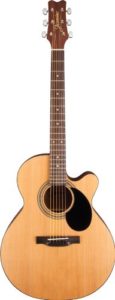
Finding an acoustic guitar that plays well and is affordable can be difficult, with the average acoustic guitar aimed at intermediate to advanced players ranging from the mid-hundreds to low thousands.
Most sub-$100 guitars are made for quantity rather than quality. Expecting an affordable guitar to play well seems unlikely.
However, there are models out there that can surpass expectations without surpassing your budget.
We’ve put together a list of the five best acoustic guitars under $100 to guide you through the vast expanse of options there are out there.
Top 5 Best Acoustic Guitars Under $100:
| Image | Model | Price |
|---|---|---|
 | Jasmine S34C (Editor's Choice) | Check Price |
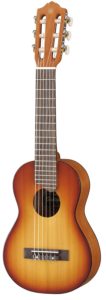 | Yamaha GL1 | Check Price |
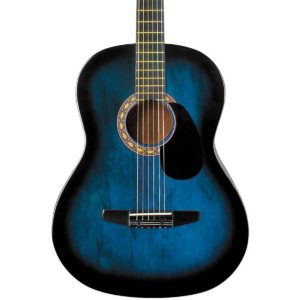 | Rogue Starter | Check Price |
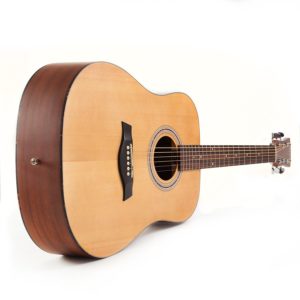 | Hola! HG-41N | Check Price |
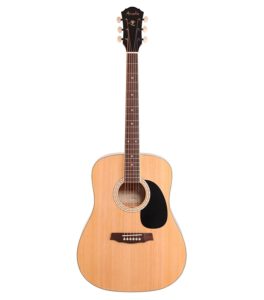 | Arcadia DL41NA | Check Price |
-
Jasmine S34C – Best Budget Acoustic Guitar (Editor’s Choice)
The first guitar we’re looking at is between $80-$100 on most online retailers.
Built solidly with a Sapele back and siding, rosewood fingerboard, laminate spruce top, and a natural finish, this dreadnought-style full-sized guitar lacks any glaringly inadequate design features.
From a neck that you can slide on easily to well-sized and even frets, your fingers don’t face any barriers to moving comfortably while you play.
There is a cutaway in the body to allow higher frets access, which is a big plus if you play on higher frets frequently.
Unlike many cheap guitars, the pegs on the Jasmine S34C do an excellent job of staying put rather than slipping out of tune.
That spares your strings from potential damage caused by frequent tightening and loosening – you can play without worrying about going out of tune in the middle of a performance.
The sound this guitar makes is of a much higher quality than the price would suggest. It has some very minor tinniness, but it doesn’t rattle, and it resonates quite nicely. Lower notes sound better than higher notes, but it plays quite clearly in all ranges.
Pros
- Strong, reliable build from body to tuning pegs
- Little to no buzzing or rattling
- Right action and comfortable play
Cons
- It comes with low-quality strings that need replacing.
This is both fun to play and enjoyable to listen to. This is our winning pick – like a guitar, and this one is not just good for the price; it’s simply a good guitar. In our opinion, it’s the best cheap acoustic guitar for under $100.
-
Yamaha GL-1 TBS Guitalele
This guitar is not a guitar – not in the traditional sense. It is a mini-guitar designed to play like a six-string baritone ukulele.
Ranging from $90-$100 online, anyone buying this instrument should not go in expecting to use this interchangeable with a traditional guitar.
Built with meranti back and sides, rosewood fingerboard, and a spruce top, this compact guitar is comfortable to hold and enjoyable to play, especially if you like the sound of a ukulele.
It does have some problems with volume – expected given its small size.
However, there isn’t any reverberation or rattling, and it sounds fun. The sweet, softer tones, with the added benefit of playing with the same six-string action you expect from a guitar.
As most small guitars do, this “guitalele” has trouble keeping the pegs from sliding out of tune. The neck is thinner than a traditional travel guitar, which is useful if you have small hands but can hinder your hands on the bigger side.
Pros
- Small, travel-friendly size
- Fun to play
Cons
- Needs frequent retuning
- The small fretboard can be hard to maneuver.
This instrument can be a fun addition to your collection, but it is not a traditional guitar and is tuned differently. While enjoyable, the price is just about accurate for what you’re getting – not a rip-off, but not a steal either.
-
Rogue Starter Acoustic Guitar
The Rogue starter guitar is both advertised and designed for beginning guitar players. Somewhere between a full-size and a ¾-sized guitar, this comes priced between $50 and $70 – very affordable.
It is decently cheaper than all the other guitars on this list. The neck is made out of maple and the fretboard of rosewood, with mahogany back.
Keeping its smaller size in mind, it plays relatively comfortably. The pegs do slip out frequently and require retuning, but this goes away with time and proper care.
It sounds pleasant when playing in low to moderate-level volumes, but it sounds more distorted at high volumes and develops some buzzing issues.
Some have described the sound as flat – a product of the more budget-friendly woods made to construct the body. This guitar isn’t meant for performances – it’s perfect for at-home, private performances, or student players.
The guitar also has a high action, which might cause some discomfort with extended playing, but it’s a minor adjustment to make.
Pros
- Cheapest guitar on the list
- Smaller size suitable for smaller hands
Cons
- Needs frequent retuning
- Not built quite as solid
- The sound is not high quality.
The Rogue starter guitar is exactly what it says it is – an excellent guitar for student guitar players who aren’t ready to make a hefty investment but don’t want the worst quality instrument on the market. For the price, there isn’t much more you could ask for.
-
Hola! HG-41N Acoustic Guitar
Suppose you’re looking for a beginner instrument before investing serious money into a guitar, the Hola! HG-41N is a solid option for anywhere from $80-$90.
It is built with a spruce top, mahogany back and sides, and a rosewood fingerboard. It doesn’t look cheap out material to drop the price.
The action is at a comfortably low level, the pegs have fewer problems with staying in place than other similarly-priced guitars, and it comes pre-strung with some pretty good quality steel strings.
There are some problems with the setup. The bridge tends to lean and shift around if you don’t glue it down – but the guitar plays quite nicely.
It has a clear, mellow tone that carries well and doesn’t buzz at all – it’s perfect in the lower registers.
This guitar is playable out of the box and is cheap enough that you would feel comfortable practicing some DIY guitar repairs on some of the smaller fixes, like adjusting the action if it’s too low for you.
Pros
- Good, mellow, clear sound quality
- Comfortable to play
Cons
- The bridge tends to give when applying tension.
This is our solid runner-up choice for a sub-$100 guitar. You should feel secure if you decide to buy this one that you got your money’s worth.
-
Arcadia DL41NA Acoustic Guitar
The Arcadia DL41 is a great instrument to play and hear. At $75-$100, it plays like it costs double. It’s got a laminate spruce top, linden back and siding, and a rosewood fingerboard.
The design features reinforced internal bracing, making this a strong guitar and plays with significant volume, even with the soft linden. It is incredibly responsive to fingerpicking.
There is some discomfort in the frets’ height – some of them vary in height a small amount, and the action is somewhat high.
You might want to take it to a luthier or get yourself a fret filer to make it more comfortable, as it can get uncomfortable to play if left alone.
It is lightweight and responsive, clear and sweet-sounding. It stays tuned, so you don’t have to concern yourself with re-tuning frequently or to stop yourself during a performance.
Pros
- Ideal for fingerpicking
- Strong volume
Cons
- High action
- Variation in fret heights gets uncomfortable.
This guitar sounds how you want an excellent guitar to sound – responsive and melodic. You wouldn’t be making the wrong decision by choosing this one.
However, some manufacturing problems could sway you towards a different model if you’re not interested in spending time fixing it.
How to Pick the Best Acoustic Guitar Under $100
Materials
Guitars will be made with different materials from the top (or “face”), the siding, the backing, the neck material, and the fretboard.
Different woods produce different sounds – if you plan on fingerpicking rather than playing with a guitar pick, choose a wood that responds better to quiet, specific notes.
While nowhere near exhaustive, the following includes several frequently used kinds of wood for lower-priced guitars:
- Spruce: commonly used for tops; highly rigid and lightweight, it carries high sound velocity and supports a natural, clear tone even when playing forcefully.
- Cedar: softwood, preferred for its warm tones; cedar is more responsive to fingerpicking than many other wood types.
- Mahogany: very sturdy, dense, and “punchy”; because it has a slow response, it’s better for strumming – popular in country and blues.
- Maple: dense wood, not frequently used by itself, but mixed in with different woods; it provides clarity when used as part of a laminate and is most frequently found as a siding or backing.
- Rosewood: heavy with a quick response; favored for its complex, rich sounds at all ranges, rosewood is a smart option for fingerboards and necks. Not often used for the entire body.
Body Styles
The shape of the body of the guitar will help determine the kind of sound you’ll be able to make and whether or not you’ll be able to play the guitar comfortably.
When shopping for an acoustic guitar, you should spend some time holding it in playing position and noting how comfortable – or uncomfortable – the shape of the guitar feels:
- Concert/Grand Concert: the traditional, symmetrical shape for acoustic guitars – the concert is better than the grand concert for smaller players; does an excellent job in the middle range and projects well.
- Auditorium/Grand Auditorium: also referred to as “orchestra”; more treble than the similarly-sized dreadnought, but a narrower waist promotes a better treble.
- Dreadnought: popular body style that boasts a large soundboard, making it “punchy” and loud; popular in blues, and ideal for performers.
- Jumbo: this large body projects quite loudly and plays deeply quite well; good for performances and gives an additional boost to quieter methods of playing like fingerpicking.
Neck Width and Strings
Wider neck guitars, often seen in classical guitar, allow for more space between the strings, which helps if you have trouble with “fat-fingering” them.
These are ideal for those with bigger hands. Guitars with narrower necks are better for those with smaller hands and fingers. Make sure to hold the neck before you consider buying one.
Another consideration is what kind of strings your guitar has. While strings are, in fact, interchangeable, some guitars are better suited for nylon, and some are better for steel strings.
Classical guitars, with wider necks, often come equipped with nylon strings. Nylon strings more subdued, quieter and are used in classical guitar, as well as folk and flamenco, most commonly.
Steel strings might be more challenging for beginners to play, as they tend to need some getting-used-to. You’ll need to build up calluses before you can play without any pain.
Steel strings are often brighter and louder, more common in rock and country – genres where volume is king.
Other Key Features
The action of a guitar refers to the space between the strings and the fretboard. If the strings are too high, it’ll take a considerable amount of pressure to press the string. That can make playing both painful and exhausting.
If it’s too low, it can catch on other strings and make a terrible buzzing noise. Actions that are too high or too low can be modified, but if you’re looking to save money and time, try to find a guitar that fits your needs upfront.
Consider the intonation of a guitar – when you play on the lower frets, it may sound fantastic, but does it get more out of tune the further up the fretboard you play?
It is likely a bad guitar, no matter the price – good intonation is vital to playing anything seriously. That is also much more difficult, if not downright impossible, to fix, so you want to make sure the intonation is good before you buy it.
Make sure the bridge is solidly placed. The bridge is the wooden part of the guitar’s body that lifts the strings above the top; if it is not glued in place properly, it will shift around, affecting both the sound and quality of your playing.
A professional can adjust it, and you can learn to adjust it yourself as well, but it’s much easier to buy it glued in the proper place.
Best Cheap Acoustic Guitar Under $100: Our Verdict
There can be some great guitars out there for affordable prices – good tonewoods, excellent playability, and beautiful sounds that play precisely how you want them to.
This list of the five best acoustic guitars under $100 is designed with picky guitar players in mind.
Whether you’re looking to play the blues, folk music, or classics, there is a guitar out there for you. You don’t have to break the bank to find it.
As we said above, the Jasmine S34C is the best cheap acoustic guitar for under $100 from all possible points of view. This all-around instrument is suitable for any beginner who loves playing guitar but doesn’t want to spend a fortune buying a much more expensive model.